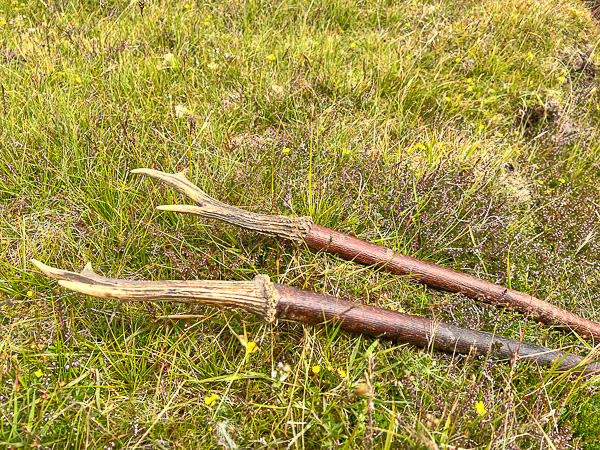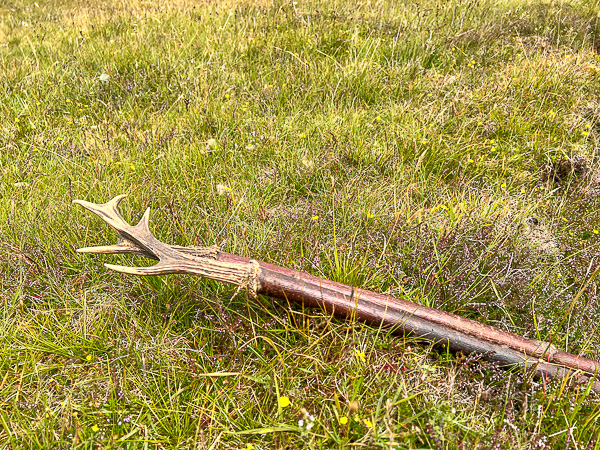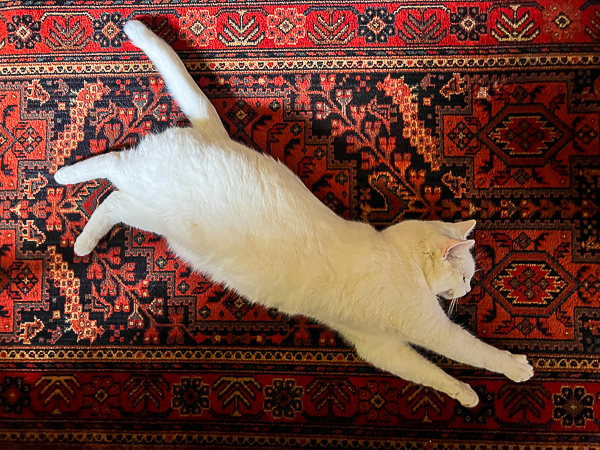I am thinking about buying a pair of trekking poles for dog-walks. Currently, I am using my mother/step-father’s walking sticks to see if they help and, although heavy, I think they do.
The pretty antler tops are utterly useless and actually annoying, as I tend to hold the sticks further down, so they are not ideal but they give me the gist of what I should be feeling if I invest in proper trekking poles.

I did find that walking with a pole in each hand really helped my balance (non existent at the best of times) and with my speed and stability. It was a great improvement. I am hopeful they would help my spine too.

Thinking all these things while I walked, I sat down on a nearby rock to look up on the internet just how to walk with trekking poles. There is a method and I couldn’t work out what was right. Apparently it is opposite leg to pole, which I find quite difficult (my brain fries while I try and change). I would make a rotten soldier marching on parade, I think.

So sitting on my rock, I then looked at Amazon for vague prices and recommendations and trekking poles can range from £30 to £200.

So my question is, do you get what you pay for? Sometimes buying the cheapest model can be a false economy. I would be using them most days to walk the dogs across rough terrain, which can include mud and snow – they need to be hard-wearing and not going to break immediately, comfortable in my hands, and the right kit for the job.
And the grippy bit? Cork or rubber or foam?


So, if you use trekking poles, your input and recommendations would be invaluable to me.

Much thanks.

Discover more from My Shetland
Subscribe to get the latest posts sent to your email.

I have a pair of poles, having used them more when recovering from a broken metatarsal than I do now, though occasionally I still find them useful for walking over rougher ground. I’m not sure whether it is standard or not but you definitely need to be able to adjust the height to suit you and you do need something sturdy to cope with rough ground. A lady in my choir uses them for walking to choir by pavements but also little bits that are rougher underfoot and they seem to help her a lot. The physio-therapist taught me to use a walking stick on the opposite side to the injured foot as that’s the way to get as much support as possible. I think using the pole on the opposite side to the foot is to get maximum support. I think it’s like a trotting horse. If you use the pole that’s on the same side as the foot you are putting forward you’ll be listing to one side and that could even cause a twisting to the spine.
I purchased my poles a few years ago.
Blue Mountain anti-shock system from Trespass.
They sold them in pairs and I think I paid about £30 in total.
They are extendable with rubber hand grips, wrist loop and optional ends for use on snow.
They told me to extend them so that my lower arm was horizontal when gripping them.
Hope that helps.
I have Nordic Walking poles that I quite like. From Norway. I don’t use them as much as I should and every time I get them out I wonder why I don’t use them more often…
thoroughly enjoy your blog but first time commenting
in our late sixties my friend and i started walking we do about seven miles up steep hills too and since using the carbon poles with rubber tips she hasnt felt her back after a walk, they are great for up and down hills and also balance on rough ground, she got hers in a discount store mine in a sports shop no dearer than £25 and still going strong though replaced the tips, go for ones that clip shut once extended not the screwing motion ones, carbon is the lighter type x
I don’t use trekking poles but have been using a Lekki walking stick since suffering a back injury 24 years ago. I find them a good make. I was considering buying poles but ill health caused change of plans. However the idea of impact reduction on joints and spine would make them ideal in your setting . Hope that you find something to suit . I love your antler sticks. I have several pairs inherited over the years and find them beautiful if not terribly practical.
I bought these trekking poles from Amazon because I slipped and fell in the icy snow. I only use them in bad weather, but they’ve been a huge help. They come with different tips for different terrain.
https://www.amazon.com/KINGGEAR-Carbon-Fiber-Hiking-Poles/dp/B0CFV1LPG9?pd_rd_w=qavz0&content-id=amzn1.sym.0c0e3277-1675-489c-a566-ea075b32087a&pf_rd_p=0c0e3277-1675-489c-a566-ea075b32087a&pf_rd_r=6XEYPXWBJVDG55TEZDKP&pd_rd_wg=OiLGl&pd_rd_r=c0633724-0217-4634-a4f3-98ad640310b7&pd_rd_i=B0CFV1LPG9&ref_=pd_basp_d_rpt_ba_s_1_t&th=1
I should add that what helped me to learn to use them properly was to think of how a horse trots, and move in diagonal pairs with the poles the horse’s front legs, and your legs the horse’s hind legs.
Yes to trekking poles Frances, do it. First saw them in Switzerland, even little kiddies 5 years old were proud to use short poles or a mountaineer’s walking stick, badge of honour, proof that they do stuff and not sit watching tele. I’m just out of hospital with a hip replacement – going good, and using elbow crutches at the mom, can get out in the ponies paddock, they are a wee bit suspicious they mean work of some kind. Soon as I don’t need crutches I’ll be a trekking poler, magic for balance in the mud or rough going.
some people around me have bought the ones from aldi and the are very happy with them.
I do a great deal of hillwalking, backpacking, hiking, and never, ever go out without one pole, even though they are nearly always sold as a pair.
I am a similar age to you and my balance is not what it used to be so these are invaluable, they also help you stand up a bit straighter which is much better for your back and lungs.
First thing – buy something really cheap to see if you like them/get on with them, but make sure you can adjust the length/height.
Second thing – ignore all the flippin’ “rules” – they are most likely made up by someone who is half your age and has no idea what your body needs, we are all different.
* Hold them however you feel most comfortable, just let it come naturally otherwise you will be tensing your body in strange ways that won’t do you spine/muscles any good.
* Do not worry about the ‘rules’ of where to place a pole, etc. Most of them are focused on Nordic Walking which is a completely different kettle-of-fish to having some support when you are walking over rough ground with dogs. Just let your body fall into a rhythm which feels natural.
* Using one pole you’ll find your body will tell you which side is the most comfortable, for me it’s always the right hand but if I am on very steep ground with the drop on my left side I will swap over so that the pole is on the downhill side to give me more support.
I only ever take one pole because I want a hand free for dog lead, camera, whatever.
If you decide you really like them, then invest in something more expensive. I have a pair of Leki carbon poles which are (these days) blisteringly expensive with left & right handed shaped grips. They’re very good but you don’t need to get that technical. Let us all know how you get on.
My daughter gifted me a pair 2 years ago. I love them. I’ve a bad hip and 2 bad knees and they’ve really made a difference when walking distances and varied terrains. Mine have a variety of tips I can use. Recently used the mud cups on soft sand and they worked wonderfully. I used the poles last weekend on grassy inclines and I found myself walking as briskly as if walking level ground. I have no others to compare them to, but mine are TrailBuddy’s ultra strong aluminum cork trekking poles. Regarding how to walk with them, I use the scientific method of not thinking about it. I start walking and they seem to sort themselves out. When I think too hard about it I’m like a foal learning to stand.